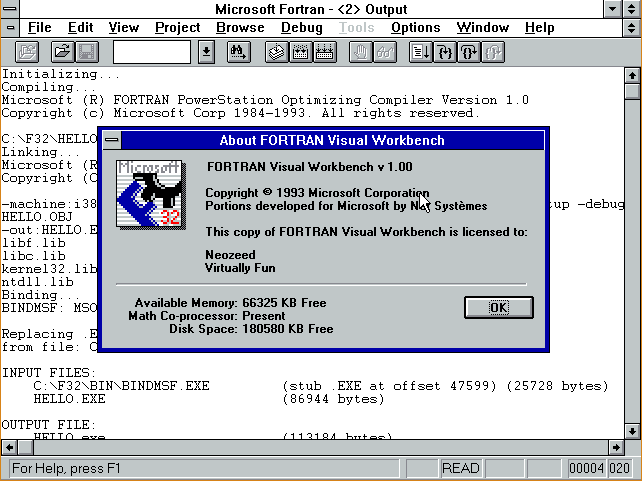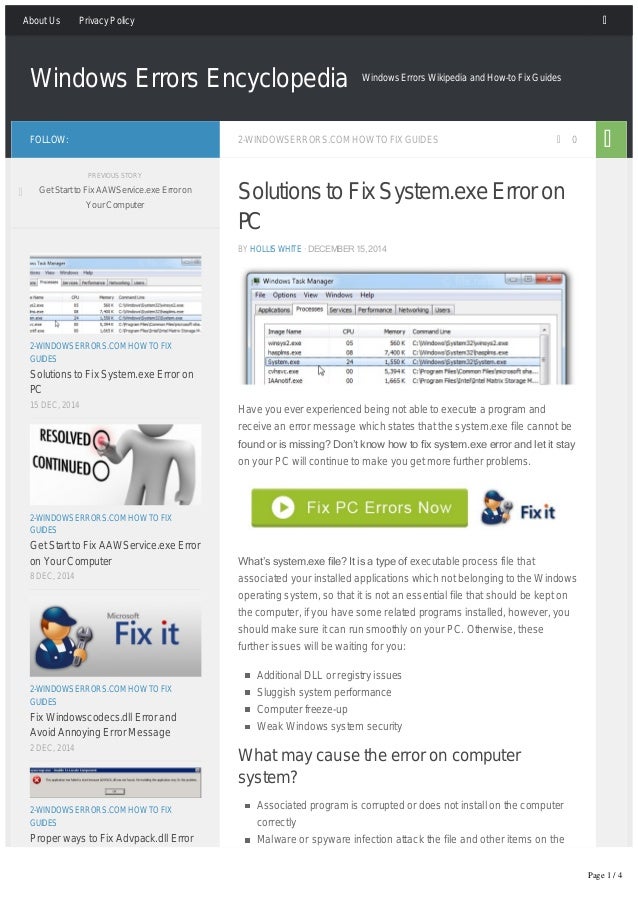Type the following command and then press Enter. To use System File Checker from the Command Prompt through Advanced Startup Options or System Recovery Options, see the Executing SFC /SCANNOW From Outside of Windows section below for some necessary changes in how you execute the command. System File Checker will now verify the. The correct array and substring indexing parentheses are , not. You also have to always use: for substrings, so quote (1:1) is necessary. There are no in Fortran 90 or 95. In Fortran 2003 items is an array constructor.
By: Scott Murray | Updated: 2014-09-26 | Comments (1) | Related: >Reporting Services Administration
Problem
Your SQL Server Report Server service will not start or you keep getting an error whenyou navigate to the SSRS URL? What logging tools are available toassist you with diagnosing SSRS problems, issues, or errors? Check outthis tip to learn more.
Solution
Most SSRS report designers are well aware of the Execution Logtables which are available in the ReportServer database. If you arenot, head over to this tip, http://www.mssqltips.com/sqlservertip/2722/sql-server-report-server-2008-r2-execution-log-reports/, whichgoes over how the Execution Log works. Although, that tip is forSSRS 2008R2, the bulk of the tip still applies to SQL Server and ReportingServices 2012.
However, if your Report Server will not start or you are seeing othererrors on your SSRS website, there are additional tools available whichcould assist with troubleshooting the problem. In actuality, there areseveral different logs which are at our disposal when working withSSRS.
- First, is the Report Server Service Trace Log; this log contains awealth of information which includes information posted by the reportserver, information posted from the SSRS web service, and detailsposted from the ReportManager. Additionally, the main log file can help track down specificerrors which may be occurring and also notates unexpected errorsexperienced by Reporting Services.
- Second, the Report Server HTTP logcan be used totrace all the http requests and responses made against your SSRS webservice. This log is like a 'log book' of your visitors. However,as compared to the trace log mentioned, above, it is not enabled bydefault. It must be enabled in the ReportingServicesService.exe.configfile. We will talk about each of these two logs in the next examplesets.
SQL Server Reporting Services Trace Log
As mentioned above, the Execution Log retains details about query and report execution in theReportServer database and is probably your first troubleshooting stop when errors arise. TheSSRS trace log is likely your second stop in your trouble shootingjourney. The information in this log is extensive and maybe in someways overwhelming. However, to assist in troubleshooting a problem,this level of detail is significant and necessary. If you have alreadyreviewed the execution log and did not find what was causing an error, the levelof detail in the trace log will be helpful in reviewing an issue.

Likely, the most common search you will do,at least initially, is for an error. This log is on by default andcan be found in: C:Program FilesMicrosoft SQLServerMSRSXX.SQL2012Reporting ServicesLogFiles or some variationdepending on your SQL Server installation. The file name starts with'ReportServerService_ 'and then is suffixed with the date and time and'.log'. You can, if you would like, change the default name for thetrace file.
Furthermore the log file is in plain text, so it isreadable with any text editor. You can actually set the trace levelfrom 0 (tracing turned off) to 4 (full verbose messaging). In order tomake these and other adjustments to the trace file, you need to modifythe ReportingServicesService.exe.config file in the ...Microsoft SQLServerMSRSXX.SQL2012Reporting ServicesReportServerbin (my directoryis for example: C:Program FilesMicrosoft SQLServerMSRS11.SQL2012Reporting ServicesReportServerbin). As shownbelow, you can adjust several of the settings in theReportingServicesService.exe.config in order customize specific logfile settings including the level of logging, the name of the log file,and the number of days to keep the log files.
Notice in the above screen print, that we can additionally adjust thefile size. Microsoft does recommend not changing the following logsettings: Prefix or TraceFileMode. Finally the last line in the screenprint specifies not only the trace level (3 in the above example), butit also allows you to specify the component categories to be includedin the trace. The default level for these options is: 'all:3'.
The categories which can be specified include:
- RunningJobs -Traces all in progress reports or subscriptions
- SemanticQueryEngine -Records semantic queries used in adhoc queries
- SemanticModelGenerator -Records trace generation for semantic models
- All - Traces all activity for all process
Now that we have the trace setup, we can now review what is actuallyin the file. As shown in the below example, the beginning of the tracefile shows a whole sundry of different values which are set when SSRSstarts. We see location information, operating system information,and various startup settings including memory, secure connectiondefaults, and clean up recycle times. The setting list actually goes onand on, so we will not cover all the settings, but this screen printshows how we can check.
Often, as you review the log, you are going to see what I call aclean log, which appears similar to the below screen print. Note how themessages state they are 'INFO' only or informational in nature.
Alternately, you may actually see warning message in the log, as illustrated in the next screen print.
Of course, these warning items should most often be looked into todetermine their root cause, but they likely would not prevent thereport server from starting.
The last main item to look forin the SSRS trace log pertains to actual errors. The below screenprints show two such error rows in the log files. The first error wasactually caused by an out of memory situation which rendered the ReportServer 'out of commission'. The second error notes a failure to load data into the Execution Log.
As you can see thetrace logs contain a wealth of information to troubleshoot issueswithin SSRS. Fortunately, we have a second set of logs which trace thehttp requests and responses to further assist with troubleshooting. Wewill discuss that log next.
SQL Server Reporting Services Report Server HTTP Log
The SSRS http log provides SSRS administrators with detailspertaining to the requests initiated against the SSRS web service.This log is not on by default, but you can adjust the sameReportingServicesService.exe.config file used to adjust the setting forthe SSRS trace log to turn on. We again can set the http log file name using theHttpTraceFileName setting while the HttpTraceSwitches setting defineswhich items are logged to the file. Included in the switch list are:
- Date and time
- ClientIP-address
- UserName
- ServerPort and Host
- Method, Protocol, and Protocol version
- Bytes received and time taken
- User Agent
- UriStem and UriQuery
- CookiesReceived and Sent
- Referrer
Thus,as shown below, we add the HttpTraceFileName and HttpTraceSwitches tothe RStrace section of the config file and finally we must add 'http:4' to the componentarea of the config file.
Now that our http traces file is turned on, we can review the httptrace log. If you have ever looked at IIS or other web server logs,these entries, shown below, should look familiar.
Again, these log items can assist you in trouble hooting user issues with their SSRS requests.
Conclusion

SSRS is setup and ready to help you troubleshoot issues with yourSSRS site. In addition to the Execution Log, SSRS administrators canalso review the SSRS trace log which is turned on by default. This logcontains a wealth of information including exceptions that weregenerated, background processing review, and logs of operationscompleted by the Report Manager and web service. Most 'clean logs' willcontain many INFO messages, but reviewing the logs will also providedetails about Warning and ERROR messages. In addition to the defaulttrace log, the SSRS http trace log provides details about the SSRS webservices receipt of requests and it's subsequent response to those requests.Both of these logs allow for customizing specific settings via the ReportingServicesService.exe.config file.
Next Steps
- Turing on SSRS Logging when in SharePoint Integrated Mode- http://msdn.microsoft.com/en-us/library/ff487871(v=sql.110).aspx
- Errors and Event References for SSRS- http://msdn.microsoft.com/en-us/library/ms165307.aspx
- AllSQL Server Reporting Services Tips
Last Updated: 2014-09-26

Error Executing Fl32.exe
Error Executing Fl32.exe. 2

About the author
Error Executing Fl32.exe. Code
View all my tips